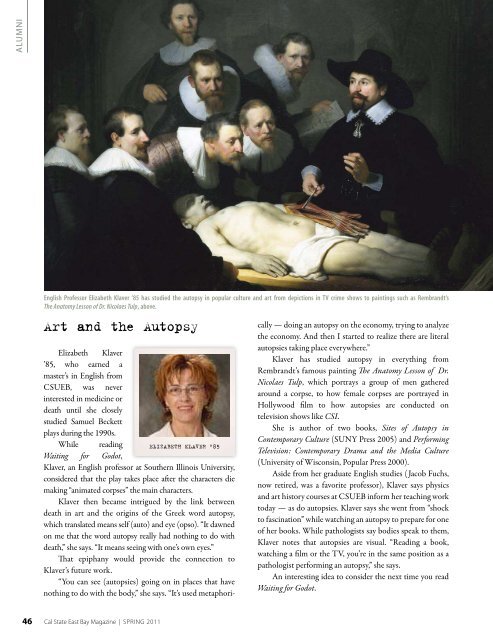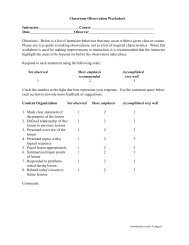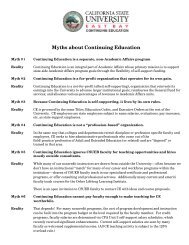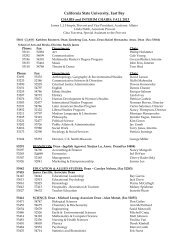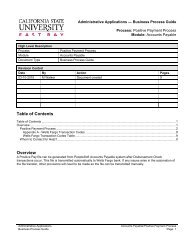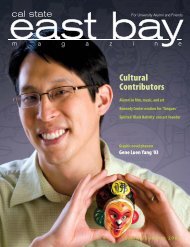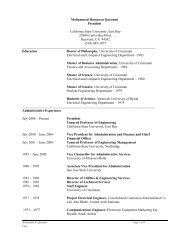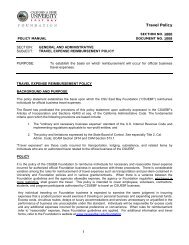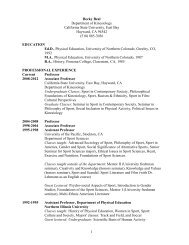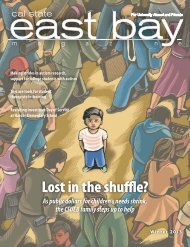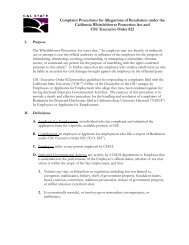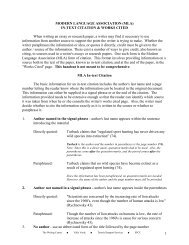Beyond CSI - California State University, East Bay
Beyond CSI - California State University, East Bay
Beyond CSI - California State University, East Bay
Create successful ePaper yourself
Turn your PDF publications into a flip-book with our unique Google optimized e-Paper software.
alumni<br />
English Professor Elizabeth Klaver ’85 has studied the autopsy in popular culture and art from depictions in TV crime shows to paintings such as Rembrandt’s<br />
The Anatomy Lesson of Dr. Nicolaes Tulp, above.<br />
Art and the Autopsy<br />
Elizabeth Klaver<br />
’85, who earned a<br />
master’s in English from<br />
CSUEB, was never<br />
interested in medicine or<br />
death until she closely<br />
studied Samuel Beckett<br />
plays during the 1990s.<br />
While reading elizabeth klaver '85<br />
Waiting for Godot,<br />
Klaver, an English professor at Southern Illinois <strong>University</strong>,<br />
considered that the play takes place after the characters die<br />
making “animated corpses” the main characters.<br />
Klaver then became intrigued by the link between<br />
death in art and the origins of the Greek word autopsy,<br />
which translated means self (auto) and eye (opso). “It dawned<br />
on me that the word autopsy really had nothing to do with<br />
death,” she says. “It means seeing with one’s own eyes.”<br />
That epiphany would provide the connection to<br />
Klaver’s future work.<br />
“You can see (autopsies) going on in places that have<br />
nothing to do with the body,” she says. “It’s used metaphori-<br />
cally — doing an autopsy on the economy, trying to analyze<br />
the economy. And then I started to realize there are literal<br />
autopsies taking place everywhere.”<br />
Klaver has studied autopsy in everything from<br />
Rembrandt’s famous painting The Anatomy Lesson of Dr.<br />
Nicolaes Tulp, which portrays a group of men gathered<br />
around a corpse, to how female corpses are portrayed in<br />
Hollywood film to how autopsies are conducted on<br />
television shows like <strong>CSI</strong>.<br />
She is author of two books, Sites of Autopsy in<br />
Contemporary Culture (SUNY Press 2005) and Performing<br />
Television: Contemporary Drama and the Media Culture<br />
(<strong>University</strong> of Wisconsin, Popular Press 2000).<br />
Aside from her graduate English studies ( Jacob Fuchs,<br />
now retired, was a favorite professor), Klaver says physics<br />
and art history courses at CSUEB inform her teaching work<br />
today — as do autopsies. Klaver says she went from “shock<br />
to fascination” while watching an autopsy to prepare for one<br />
of her books. While pathologists say bodies speak to them,<br />
Klaver notes that autopsies are visual. “Reading a book,<br />
watching a film or the TV, you’re in the same position as a<br />
pathologist performing an autopsy,” she says.<br />
An interesting idea to consider the next time you read<br />
Waiting for Godot.<br />
To Catch a Cyber Thief<br />
When Albert<br />
Gonzalez, mastermind<br />
of the largest hacking<br />
and identity theft<br />
scheme in U.S. history,<br />
was indicted in 2009<br />
Joe Majka ’81 knew he<br />
had done his job.<br />
Majka, who is<br />
Joe Majka '81<br />
senior business leader<br />
in Cyber Security and<br />
Investigations at Visa, worked with the Department of<br />
Justice and the U.S. Secret Service for years tracking<br />
Gonzalez, a self-taught programmer accused of stealing<br />
data from more than 130 million credit and debit cards.<br />
For Majka, fraud and data theft cases are typically<br />
complex, lengthy and international in scope, involving<br />
slippery online characters who sell the data they steal.<br />
Gonzalez was “the most notorious,” he says.<br />
Majka joined Visa in 1996 after working as a Pleasanton<br />
police officer and in bank security. Majka’s job entails<br />
policing security on a network that serves as the connection<br />
point between 1.6 billion global payment cards, 29 million<br />
worldwide merchants, and 16,600 financial institutions in<br />
170 countries.<br />
While the banks typically hire their own investigators<br />
to handle smaller fraud and data theft cases, Majka’s nineperson<br />
team jumps in on cross-border investigations<br />
involving multiple banks. “If we can see that several banks<br />
are being attacked in the same way then we help coordinate<br />
(the investigation),” he says. About 90 percent of his team’s<br />
work is investigating hackers who attack merchants and<br />
credit card processors to steal data.<br />
Majka says his early college studies at Cal <strong>State</strong> <strong>East</strong> <strong>Bay</strong><br />
in sociology helped him understand the criminal mind<br />
“from the street criminal to the white collar criminal.”<br />
Last year, Majka was asked to testify before the House<br />
Committee on Homeland Security on the topic “Do the<br />
Payment Card Industry Standards Reduce Cybercrime”<br />
(Majka argues that they drastically do help and that the<br />
companies that adopt these standards are protected.)<br />
Asked whether his work has made him reluctant to use<br />
bank cards, Majka laughs. “I feel very comfortable,” he says.<br />
After all, with a stolen card, he says, there’s bank protection<br />
and a trail to follow. With cash, the money’s just gone. n<br />
Passionate<br />
pursuits<br />
<strong>University</strong> alumni have pursued a passion for criminal<br />
justice and forensic science in diverse professions. Here is<br />
a sampling:<br />
• Mystery writer Charlotte Elkins ’72, teaching credential<br />
’74, writes a series of detective novels with her husband,<br />
Aaron, about Lee Ofsted, a struggling female professional<br />
golfer. Elkins is past recipient of the Agatha Award for<br />
best short story of the year.<br />
• Anthony “Tony” Hare ’77 is a forensic clinician with the<br />
San Francisco Forensic Institute and a visiting scholar<br />
at the <strong>University</strong> of <strong>California</strong>, Berkeley. He served for<br />
24 years with the Oakland Police Department. His<br />
leadership of the Hostage Negotiation Team led to new<br />
guidelines for incidents where traditional responses<br />
don’t work.<br />
• Assistant Chief Howard A. Jordan ’06 has served the<br />
Oakland Police Department for more than 20 years on<br />
patrol, investigations, internal affairs, and administration.<br />
He manages approximately 800 officers and 370<br />
non-sworn personnel and saw the department through<br />
the 2009 shootings of four police officers.<br />
• Cory Louie ’98, a former special agent for the U.S.<br />
Secret Service, serves as trust and safety manager<br />
for Google. His position involves managing global<br />
risk, abuse, and fraud issues. His Secret Service<br />
training included investigation of network intrusions<br />
and cybercrimes.<br />
• Ronald J. Miller ’86, owner of Behavioral Forensics and<br />
Investigations, specializes in detailed and in-depth<br />
psychosocial background investigations related to death<br />
penalty murder litigation.<br />
• Psychologist Claude S. Munday ’77 conducts medicallegal<br />
evaluations as a qualified medical examiner for<br />
Newton Medical Group in Oakland where he specializes<br />
in workers compensation and personal injury cases.<br />
• Diane Urban ’86, as acting assistant chief of the<br />
San Jose Police Department from late 2010 until<br />
January 2011, became the highest-ranking female<br />
officer in department history. She also has worked<br />
as a sniper and hostage negotiator. She is a graduate<br />
of the Senior Management Institute for Police and the<br />
West Point Leadership Program hosted by the Los<br />
Angeles Police Department, where she teaches.<br />
46 Cal <strong>State</strong> <strong>East</strong> <strong>Bay</strong> Magazine | SPRING 2011<br />
Cal <strong>State</strong> <strong>East</strong> <strong>Bay</strong> Magazine | SPRING 2011<br />
47


